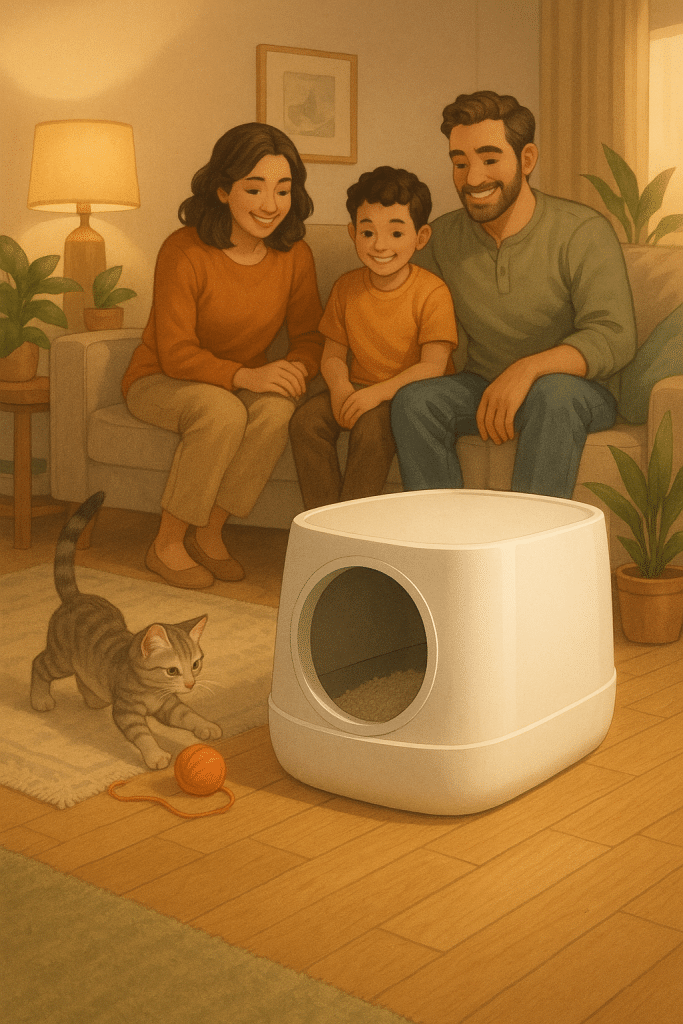If you’re a pet owner or part of a family bringing a new feline friend into your home, mastering litter box training cats is likely top of your mind. Whether you’re welcoming a curious kitten or adopting an adult cat, successful litter box training is key to maintaining a clean and happy household. But why is this seemingly simple task sometimes a challenge? With varying cat breeds, personalities, and behaviors, it’s not always a one-size-fits-all solution. Luckily, by understanding feline habits, choosing the right supplies, and adopting consistent, positive training techniques, you can set your cat up for success.
In this comprehensive guide, I’ll walk you through everything from decoding your cat’s natural instincts and selecting the perfect litter box to creating training schedules and fixing common issues. I’ll also touch on breed-specific needs and how to navigate multi-cat households. By the end, you’ll have practical, expert-backed strategies to ensure that your cat takes to the litter box with confidence and ease. Let’s dive into the world of litter box training cats for happier pets and owners alike.
Understanding Feline Elimination Habits and Behavior
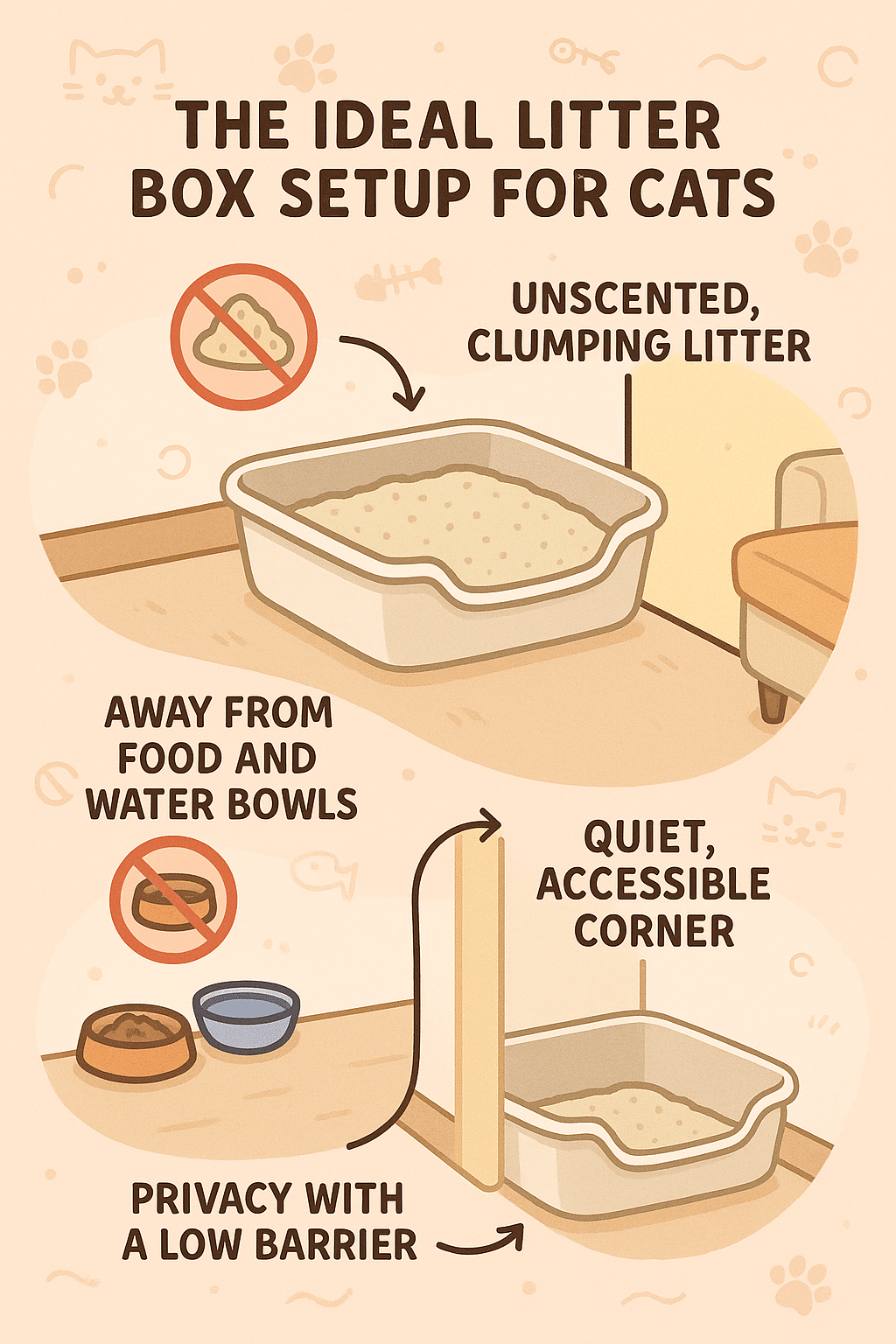
Natural Instincts Influencing Litter Box Use
Cats are naturally clean animals, often burying their waste to avoid attracting predators in the wild. This instinct is precisely why litter boxes appeal to them—they simulate a natural digging and covering environment. When a cat searches for a spot to relieve itself, it is following deeply ingrained behaviors developed over thousands of years.
Kittens begin experimenting with elimination behaviors as early as three weeks old, observing and mimicking their mother’s habits. This makes early kitten potty training much easier, as their instincts are fresher and more flexible. However, adult cats, especially rescue cats used to outdoor elimination, may need more patient guidance.
Environmental factors also play a role. Cats tend to avoid dirty or overcrowded elimination areas, so a clean, well-maintained box is essential. For example, a study from the American Association of Feline Practitioners noted that most cats refuse to use soiled boxes, which results in unwanted accidents.
Common Behavioral Challenges in Litter Box Training
Behavioral challenges can create hurdles in litter box training. These include litter box avoidance, marking behavior, anxiety-related issues, and territorial disputes—especially in multi-cat households.
Litter box avoidance often stems from medical problems (urinary tract infections, bladder stones) or negative associations (painful elimination, dirty boxes). Urine marking—distinct from elimination—is a territorial response usually related to stress or competition, where cats spray vertical surfaces. It’s vital to recognize these differences early: urine marking requires different behavioral interventions and sometimes medical attention.
Anxiety and stress—whether due to new environments, other pets, or changes in routine—can cause a cat to avoid their litter box. Understanding these root causes is the first step toward resolving issues effectively. For example, shy cats may prefer covered boxes or secluded placement to feel secure during elimination.
Selecting the Ideal Litter Box and Litter Type for Training
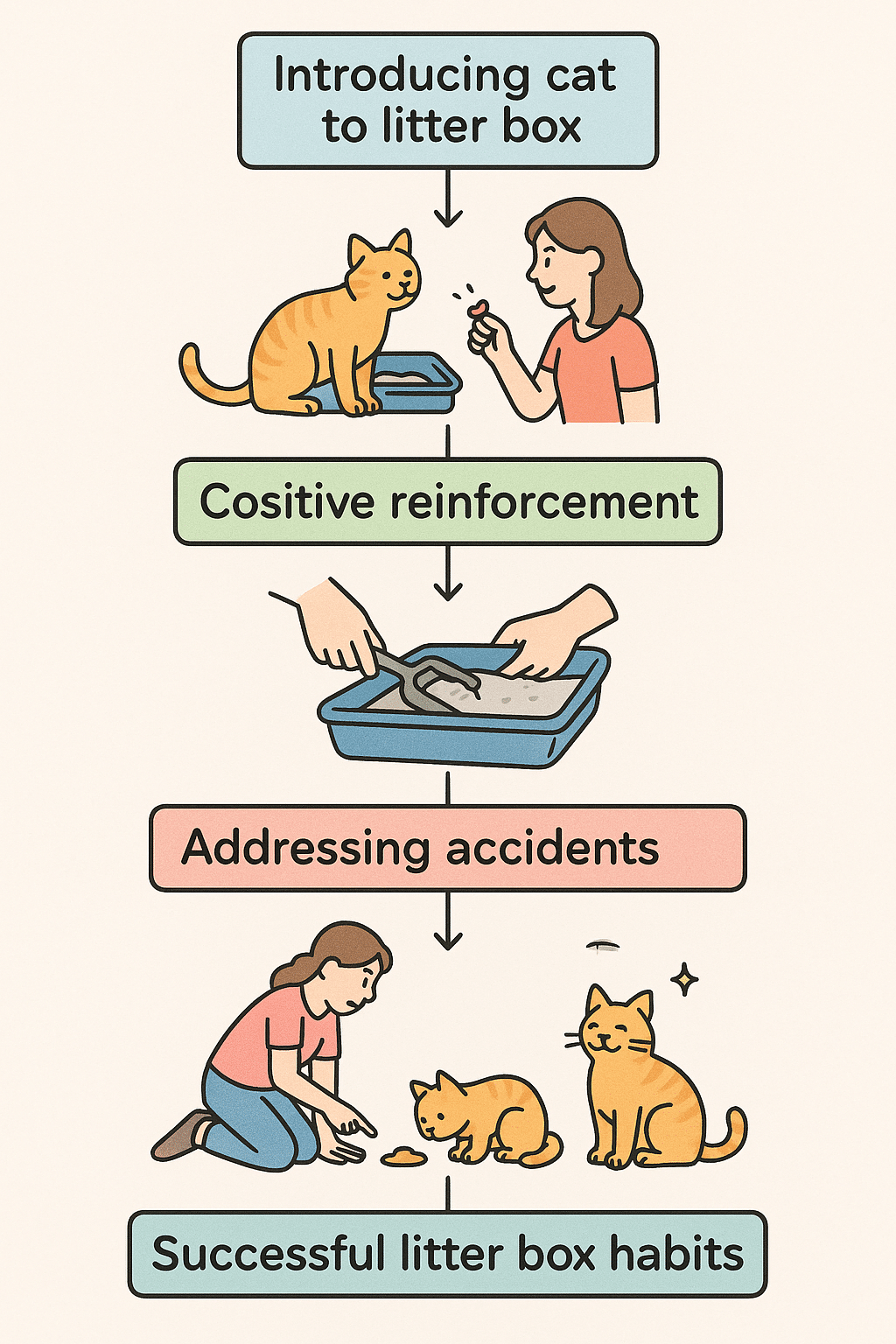
Comparing Clumping, Non-Clumping, and Natural Cat Litters
Choosing the right litter is pivotal for litter box training cats. The variety can be overwhelming, but understanding the pros and cons helps make an informed decision.
-
Clumping Litter: Usually made of bentonite clay, this type forms firm clumps when exposed to moisture. It’s popular because it is easy to scoop and maintain, helping to control odor effectively. Beginners often find clumping litter more manageable. However, some cats or owners may dislike dust or scent additives.
-
Non-Clumping Litter: Typically composed of clay or other materials, it absorbs moisture but does not clump. It may require more frequent full changes and cleaning. It’s often less dusty and can be gentler for sensitive cats or kittens.
-
Natural Litters: These include materials like corn, walnut shells, pine, or wheat. Natural litters are biodegradable and often more environmentally friendly. Some cats prefer their texture and scent, but they vary widely in dust levels and odor control.
For kittens, softer, dust-free litters such as natural or non-clumping are usually recommended to protect their delicate respiratory systems. Adult cats’ preferences will depend on previous experience and sensitivity. I recommend slowly introducing new litters mixed with familiar ones when switching to prevent rejection.
Considering Box Size, Shape, and Accessibility for Different Breeds
Litter box design is more important than many realize. Box size and shape should accommodate your cat’s breed and comfort. Larger breeds, like Maine Coons or Norwegian Forest Cats, require bigger litter boxes with higher walls to prevent spillage but ensure ease of entry. Conversely, shy or senior cats may prefer lower sidewalls for easier access.
Covered boxes provide privacy and reduce odor spread but can trap smells if not ventilated properly—this may deter some cats. Open boxes are preferable for kittens and older cats who may struggle with confined spaces. For multi-cat homes, having multiple boxes (one per cat plus one extra) placed in different quiet locations reduces territorial conflicts and encourages consistent use.
Crafting an Effective Litter Box Training Schedule for Kittens and Adult Cats
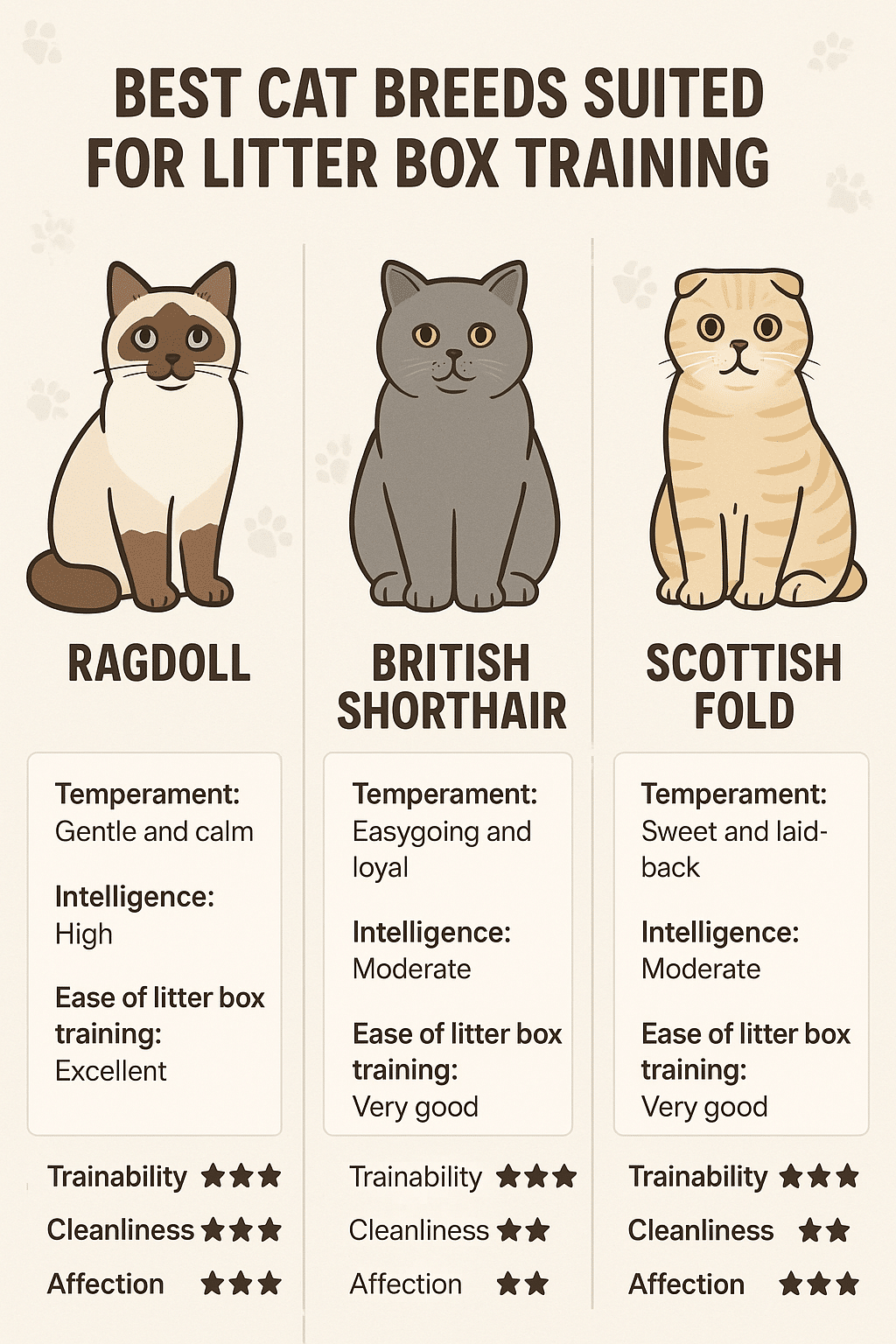
Step-by-Step Guide to Establishing Consistent Training Routines
The key to success lies in consistency and patience. Here’s a step-by-step guide to establish a routine:
- Introduce the Litter Box Early: For kittens, place them in the box after meals, naps, and play sessions. This reinforces their instincts.
- Use gently scented or unscented litter that your cat prefers.
- Observe and gently place your cat in the box if you notice signs they need to go (sniffing, crouching).
- Praise verbally or with gentle petting immediately after successful elimination.
- Keep a fixed schedule and feeding times to regulate bowel movements.
- Clean accidents with enzyme cleaners to remove odors fully — cats may return to soiled spots otherwise.
- Adjust box locations if necessary for privacy or convenience.
Adult cats may need longer adaptation periods. Patience is your best tool here. For outdoor cats transitioning inside, provide a gradual change by placing a litter box outdoors at first, then moving it stepwise indoors.
Managing Multiple Cats: Strategies for Multi-Cat Households
When you have multiple cats, litter box training becomes more complex. The golden rule is to have one litter box per cat plus an extra. This avoids competition that causes stress and marking.
Place boxes in different locations, not clustered together, giving each cat their own space. Monitor box use and watch for signs of dominance or bullying. Some cats may prefer their own boxes with distinct litter types. For example, a timid cat might favor a covered box while a dominant cat prefers open areas.
Using pheromone diffusers like Feliway in litter box areas can help reduce anxiety and territorial behaviors, promoting peaceful sharing.
Positive Reinforcement Techniques to Encourage Proper Litter Box Use
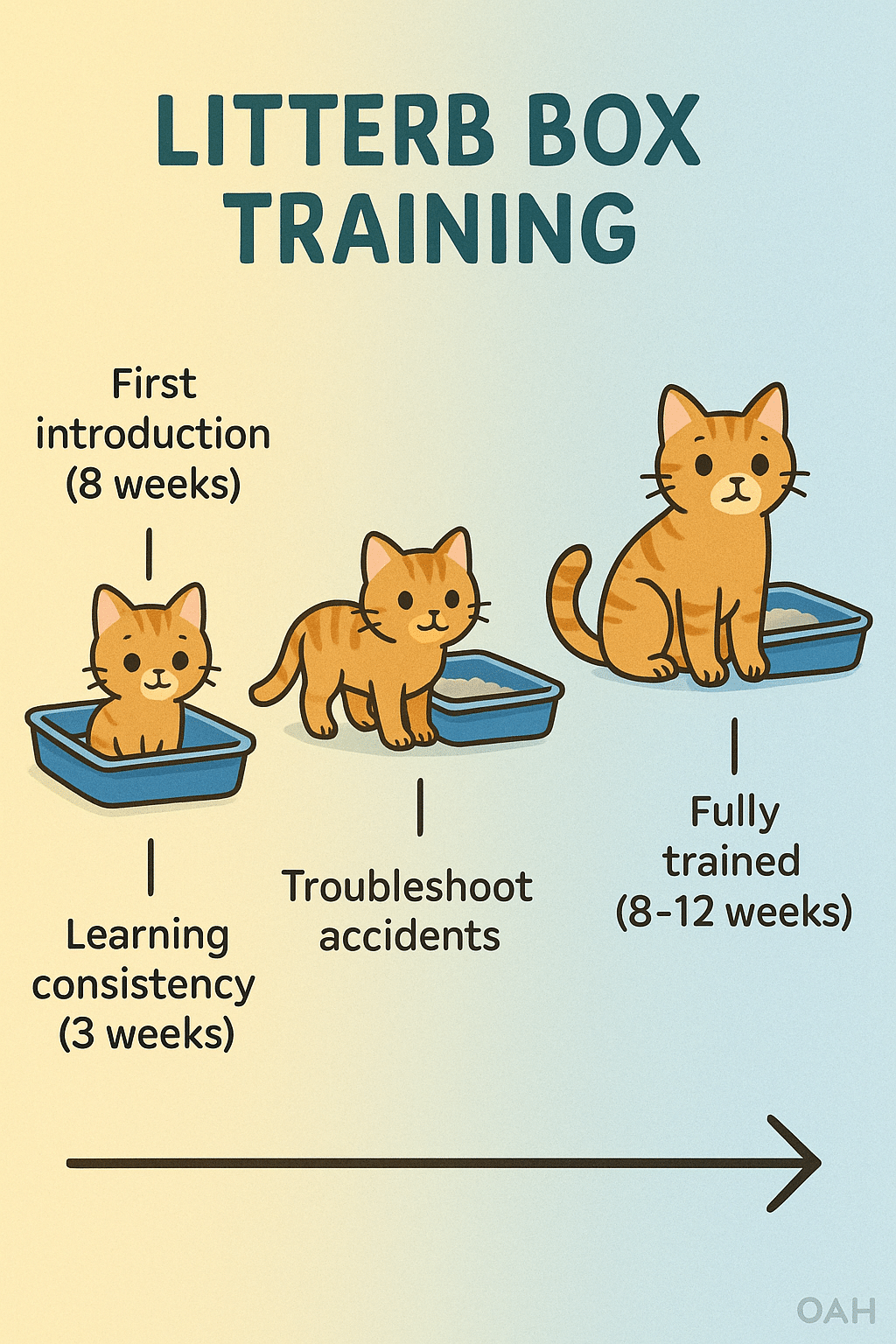
Reward Systems and Monitoring Progress Without Punishment
Positive reinforcement is the cornerstone of successful litter box training cats. Cats respond well to rewards such as treats, playtime, or affection immediately after they use the box correctly.
Avoid punishment—it creates fear and confusion, leading to mistrust or hiding behaviors. Instead, use clicker training or verbal praise with small treats to reinforce desired habits.
Keep a training log to track successes and setbacks. Apps or simple notebooks can help you identify patterns and adjust techniques accordingly.
Handling Litter Box Avoidance Due to Anxiety or Stress
Stress-related aversion requires a multifaceted approach. Start by ensuring the litter box’s location is quiet, private, and accessible. Reduce household noise and chaotic activity near the box.
Consider calming supplements or pheromone products to ease anxiety. Provide hiding spots and high perches to allow your cat to feel secure elsewhere in the home, which reduces stress overall.
If avoidance continues, consult a veterinarian to rule out medical causes such as cystitis or bladder infections. A combined veterinary and behavioral approach is often best.
Maintaining Hygiene and Cleaning Practices to Promote Litter Box Use
Safe Cleaning Products and Odor Control Methods
Routine cleaning is vital to prevent your cat from rejecting their box due to odor or dirt. Scoop waste daily and replace litter fully at least once a week, or more frequently for multiple cats.
Use unscented, pet-safe cleaning products like diluted vinegar or enzymatic cleaners to disinfect. Avoid bleach or harsh chemicals that irritate sensitive noses.
Odor control can be enhanced with activated charcoal liners or baking soda mixed into the litter (sparingly).
Routine Box Maintenance to Prevent Urine Marking and Accidents
Maintaining box hygiene also helps prevent urine marking outside the box due to lingering smells. Regular cleaning breaks the cycle of unwanted spraying.
Keep spare litter boxes on hand during intensive cleaning or if you travel frequently. In multi-cat homes, cleaning one box at a time while others remain accessible is critical.
Repair scratched or damaged boxes regularly, as rough surfaces can discourage use.
Troubleshooting Common Litter Box Problems and Solutions
Identifying Signs of Health Issues Requiring Veterinary Attention
If your cat suddenly stops using the litter box or shows signs of distress when eliminating, consider medical issues first. Symptoms such as straining, blood in urine, frequent attempts without results, or vocalizations signal a potential urinary tract problem.
Immediate veterinary consultation is essential; untreated urinary tract infections can become life-threatening.
Transitioning Outdoor or Shy Cats to Indoor Litter Box Use
Outdoor or feral cats may not immediately grasp indoor elimination. Start by placing litter boxes in safe, sheltered locations outdoors before gradually moving them indoors.
For shy cats, provide quiet spaces with covered boxes and minimize household traffic nearby. Consistent routines and patience facilitate gradual acceptance.
Differentiating Between Marking and Accidents: Behavioral Insights
Understanding the difference between spraying (marking) and accidents is crucial. Marking typically involves small squirts of urine on vertical surfaces, often combined with scratching. Accidents are full eliminations on horizontal surfaces like floors or beds.
Address marking by reducing stressors and using deterrent sprays, while accidents may require retraining and cleaning to remove odors fully.
Breed-Specific Tendencies Impacting Litter Box Training Success
Understanding How Different Breeds May Influence Training Needs
Certain cat breeds exhibit distinctive behaviors affecting training. For example, Siamese cats are highly social and vocal, often seeking attention at the litter box, which may require more interactive training.
Sphynx cats, lacking fur, may prefer warmer and softer litter to avoid cold or rough textures. Maine Coons’ large size demands roomy, sturdy boxes.
Recognizing these breed quirks allows you to tailor training approaches effectively.
Tailoring Strategies for High-Energy or Anxious Cat Breeds
High-energy breeds like Bengals can be notoriously curious and easily distracted during training. Short, frequent training sessions combined with engaging toys nearby can help.
Anxious breeds such as Russian Blues benefit from calming environments, consistent routines, and positive reinforcement that builds trust.
Creating Optimal Litter Box Placement and Environment
Balancing Privacy, Accessibility, and Household Dynamics
Litter box placement should strike the right balance between privacy and easy access. Place boxes in quiet, low-traffic areas away from noisy appliances or busy hallways.
For homes with children, a discreet location protects the cat’s dignity while accommodating the family’s schedule.
Avoid placing boxes near food and water bowls—cats find this unappealing.
Utilizing Confinement and Space Management During Initial Training
For kittens or newly adopted cats, confining them to a smaller, safe space with easy access to the litter box helps build habits. As they learn, gradually increase their roaming area.
Using baby gates or pet pens during training phases prevents accidents and fosters a secure environment.
Leveraging Veterinary and Training Resources for Ongoing Support
When to Seek Professional Help for Persistent Litter Issues
If litter box problems persist after thorough at-home efforts, professional help is invaluable. Veterinary behaviorists and certified cat trainers offer personalized strategies.
Persistent litter box avoidance, marking, or accidents may indicate underlying health or psychological challenges needing expert intervention.
Recommended Products and Tools to Aid Training Efforts
Several tools ease the training process:
- Self-cleaning litter boxes reduce odor and labor, encouraging box use.
- Pheromone diffusers help calm anxious cats.
- Litter mats minimize scatter and keep areas tidy.
- Scooping tools and odor neutralizers improve hygiene.
Brands like PetSafe and Feliway offer trusted products backed by research.
FAQs
Q1: What is the best litter box training tips for kittens?
A1: Start early with consistent placement, use soft, unscented litter, praise successes, scoop daily, and keep the box clean and accessible.
Q2: How to litter box train adult cats who previously eliminated outdoors?
A2: Gradually move outdoor litter boxes indoors, maintain cleanliness, use positive reinforcement, and provide quiet, private spaces.
Q3: What types of cat litter are best for training kittens?
A3: Dust-free, non-clumping natural litters such as pine or paper pellets are safest for kittens’ respiratory health.
Q4: How can I stop cats from avoiding the litter box?
A4: Identify and eliminate causes such as dirty boxes, medical issues, stress, or inappropriate litter; reinforce positive habits without punishment.
Q5: What are signs of litter box training issues in cats that need veterinary attention?
A5: Straining, vocalizing, blood in urine, frequent attempts without results, and sudden avoidance should prompt a vet visit immediately.
Quick Takeaways/Key Points
- Cats’ natural instincts favor clean, private elimination spots.
- Choose litter (clumping vs. natural) and box design based on breed and cat preferences.
- Consistent training schedules and positive reinforcement maximize success.
- Multi-cat homes require extra boxes and spatial planning to avoid conflicts.
- Cleanliness and odor control are crucial to prevent litter box avoidance.
- Medical issues often underlie sudden litter problems—consult a vet promptly.
- Breed and personality impact litter training methods and box preferences.
Conclusion
Mastering litter box training cats can feel daunting, but with the right knowledge and persistence, it’s an entirely achievable goal. Understanding your cat’s instincts, selecting suitable litter and boxes, creating consistent training routines, and tackling issues with patience makes all the difference. Remember, each cat is unique—adjusting your approach to their personality and breed traits fosters a trusting, stress-free environment that encourages proper litter box use.
As pet owners, your care and attention play a vital role in your cat’s comfort and wellbeing. Don’t hesitate to use professional resources and the right products to support your journey. Keep your litter boxes clean, provide positive reinforcement, and watch as your furry companion confidently adapts their natural habits indoors.
Ready to start? Gather your supplies, prepare a comfy training space, and embrace this rewarding process. Your cat—and your home—will thank you!

